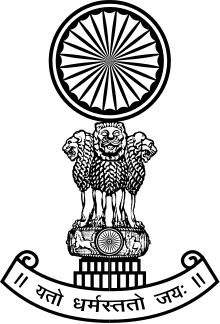Judicial activism in India
The Supreme Court of India (Hindi: भारत का सर्वोच्च न्यायालय) is the highest judicial forum and the final court of appeal of India, established under Constitution of India, according to which the Supreme Court is the highest constitutional court and acts as the guardian of Constitution. India has an integrated and yet independent judiciary.[1]
| Supreme Court of India भारत का उच्चतम न्यायालय | |
|---|---|
 Seal of the Supreme Court | |
| Established | 28 January 1950 |
| Location | Tilak Marg, New Delhi, India, 110 021 |
| Coordinates | 28.622237°N 77.239584°E |
| Motto | यतो धर्मस्ततो जयः॥ Whence law (dharma), thence victory. |
| Composition method | Collegium System (Qualifications imposed) |
| Authorized by | Constitution of India |
| Judge term length | 65 years of age |
| Number of positions | 34 (33 + 1) |
| Website | supremecourtofindia.nic.in |
| Chief Justice of India | |
| Currently | [Sharad Arvind Bobde] |
| Since | 3 October 2018 |
| Lead position ends | 17 November 2019 |
 |
|---|
| This article is part of a series on the politics and government of India |
|
National coalitions
|
|
|
Since independence, the judiciary has played a very active role in dispensing justice since the A K Gopalan vs State of Madras case (1950) followed by the Shankari Prasad case, etc. However, the judiciary remained submissive until the 1960s but its assertiveness started in 1973 when Allahabad High Court rejected the candidature of Indira Gandhi. The introduction of public interest litigation by Justice V.R. Krishna Iyer further expanded its scope.[2]
References
- Nidhi Gupta (4 April 2017). "Judicial activism v. Judicial Adventurism". LawJi.in. Retrieved 18 November 2018.
- T. R. Andhyarujina, "Disturbing trends in judicial activism", The Hindu, 06 August 2012 Retrieved 21st December 2019